Samaaro + Your CRM: Zero Integration Fee for Annual Sign-Ups Until 30 June, 2025
- 00Days
- 00Hrs
- 00Min
In the fast-paced world of event marketing, success often hinges on your ability to deliver seamless, engaging experiences. Event apps have become indispensable tools for achieving this, transforming how marketers plan, execute, and analyze their events. These apps not only simplify event logistics but also elevate the attendee experience by fostering engagement and personalizing interactions.
If you’re not yet leveraging an event app, it’s time to reconsider. Let’s dive into the essential features that every marketer should look for when choosing the right event app.
Event apps have evolved far beyond basic scheduling tools. They’re now comprehensive platforms designed to connect people, streamline processes, and generate actionable insights. With the right event app, marketers can:
In short, a well-designed event app empowers marketers to focus on what truly matters—creating memorable and impactful events.
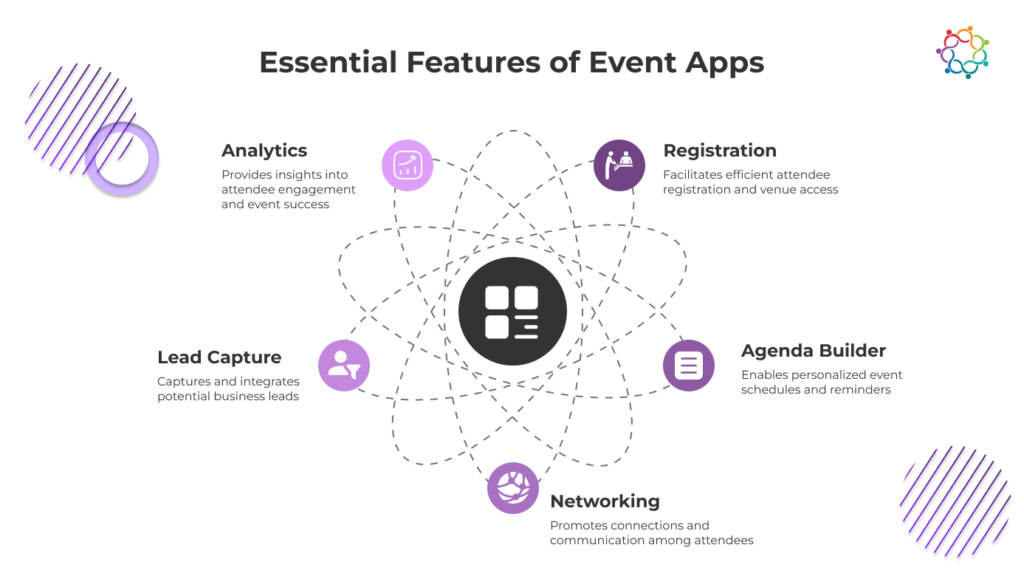
The features you choose in an event app can significantly impact your event’s success. Here are the must-have functionalities to consider:
The registration process sets the tone for your event. A smooth and intuitive system can leave a positive first impression while capturing critical attendee data.
An agenda builder is one of the most impactful ways to personalize the attendee experience.
Networking is a cornerstone of any successful event, and your app should facilitate meaningful connections.
Lead generation is a top priority for many marketers, and the right app can simplify this process.
To gauge the success of your event, analytics are indispensable.
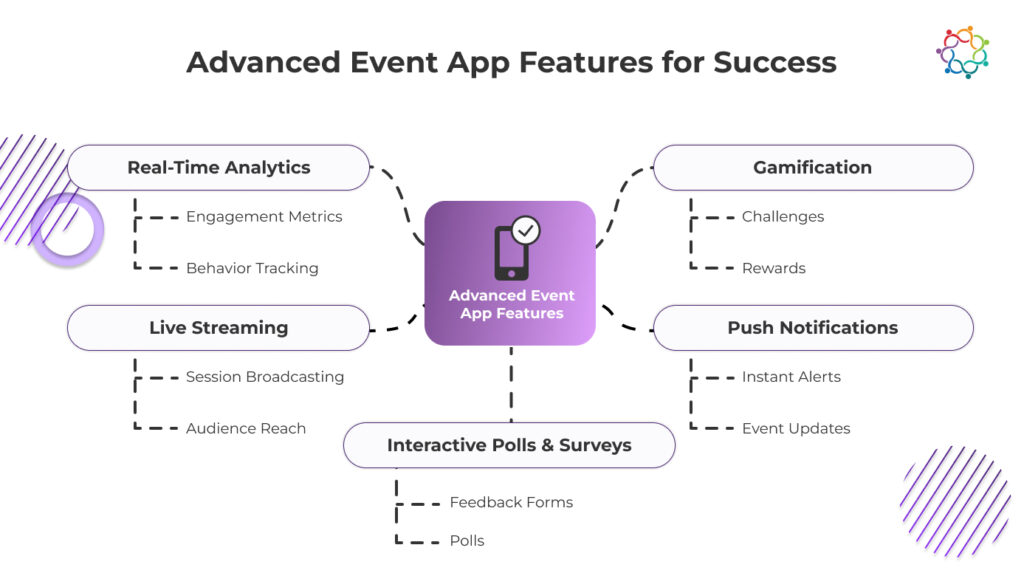
While the core features above are essential, here are a few additional functionalities that can add even more value to your event app:
Encourage participation and engagement with challenges, leaderboards, and rewards. Gamification can make the event experience more enjoyable while driving attendee interactions.
Capture real-time feedback by incorporating live polls and surveys into your sessions. Use this data to adjust programming on the fly or to enhance future events.
Ensure attendees stay informed with timely updates, reminders, and alerts. Whether it’s announcing a change in schedule or promoting a sponsor, push notifications are a direct line to your audience.
Allow attendees to interact with speakers in real time through live Q&A sessions. This feature boosts engagement and makes sessions more dynamic.
With so many event apps on the market, selecting the right one can feel overwhelming. Here’s what to consider:
Ensure the app has all the essential features your event requires, from registration and agenda building to analytics and networking tools.
The app should be intuitive and easy to navigate, both for attendees and event organizers. A clunky interface can detract from the overall experience.
Look for apps that integrate seamlessly with your existing tools, such as CRM platforms, marketing automation software, and payment gateways.
Choose an app that fits within your budget while delivering maximum value. Don’t compromise on essential features for the sake of cost savings.
Samaaro is one such platform that stands out in the crowded marketplace. It offers a suite of features tailored to marketers’ needs, ensuring a seamless event experience from start to finish.
Event apps are no longer optional in today’s marketing landscape—they’re a necessity. From simplifying event management to enhancing attendee engagement, these apps have become indispensable tools for modern marketers.
By leveraging features like personalized agendas, real-time analytics, and robust networking tools, you can create events that resonate deeply with your audience and deliver measurable results.
Ready to take your event marketing to the next level? With Samaaro, you’ll have access to cutting-edge tools designed to streamline your processes and maximize ROI. Book a demo or start your free trial today, and discover how Samaaro can help you create unforgettable event experiences.
Event marketing has evolved dramatically over the years, moving from intuition-driven decisions to strategies deeply rooted in data. In today’s competitive landscape, where every interaction counts, leveraging event data can transform your campaigns and deliver measurable success. From improving attendee experiences to optimizing lead generation, data empowers marketers to make smarter, more impactful decisions.
Let’s explore how data-driven event marketing can unlock new levels of success and why collecting, analyzing, and using event data should be at the heart of your strategy.
Data is the backbone of modern event marketing. It helps answer critical questions: Who are your attendees? What did they enjoy? What didn’t resonate? More importantly, it provides actionable insights that can shape future events, ensuring they are more engaging and impactful.
When used effectively, data can:
In short, data turns guesswork into certainty, giving marketers the tools they need to continuously refine and elevate their events.
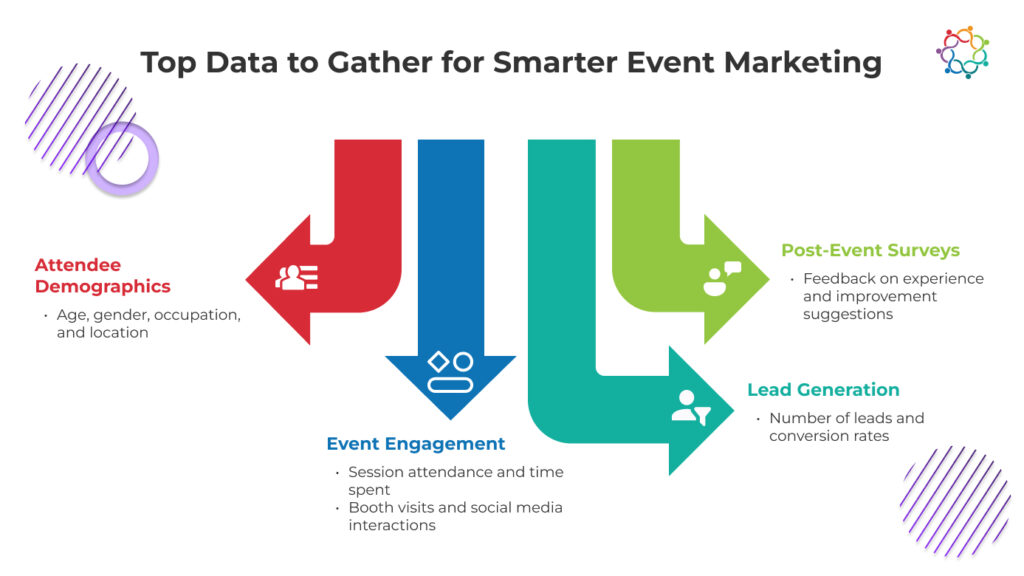
To fully harness the power of data, it’s essential to focus on the right metrics. These key data points will provide a comprehensive understanding of your event’s performance:
Understanding who your attendees are is the foundation of data-driven event marketing. Collect information such as:
This data allows you to tailor content, sessions, and activities to meet the needs of your audience.
Engagement metrics reveal how attendees interacted with your event. Track:
These insights highlight which aspects of your event resonated most with your audience.
One of the primary goals of most events is to generate high-quality leads. Key metrics include:
By understanding the quality of leads generated, you can assess the event’s impact on your business goals.
Direct feedback from attendees is invaluable. Surveys can provide insights into:
Attendee feedback helps refine future events and ensure you’re meeting their expectations.
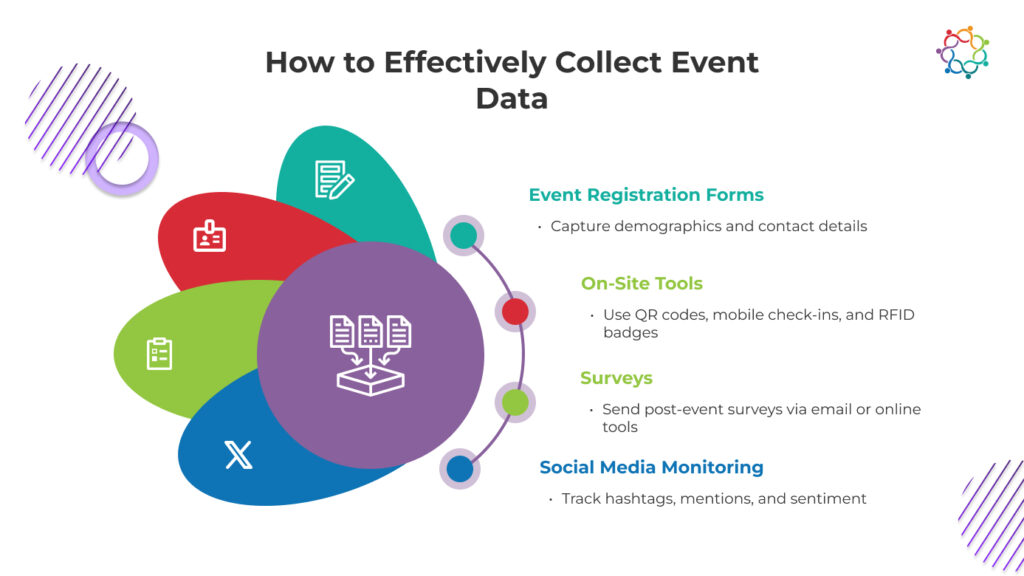
Data collection is as much about the method as it is about the metrics. Using the right tools and techniques ensures accuracy and completeness:
Registration is often the first point of contact with attendees, making it a prime opportunity to gather data. Use forms to collect basic demographic information and preferences. Customize fields to capture details relevant to your event objectives.
Events provide numerous opportunities for on-site data collection, such as:
Send surveys via email or use online tools to collect post-event feedback. Keep surveys concise and focused to maximize response rates.
Track event-related hashtags, brand mentions, and attendee sentiment on social media platforms. This not only provides engagement metrics but also gives insights into how your event was perceived.
Collecting data is only the first step. The real value lies in analyzing it to uncover actionable insights.
Dive into the data to understand your attendees better:
By identifying trends, you can refine your event strategies to align with audience preferences.
Event marketing is an investment, and data helps you measure its return. Calculate:
Understanding ROI demonstrates the event’s value to stakeholders and secures buy-in for future initiatives.
Use data to segment attendees based on their behavior, preferences, and demographics. This allows you to create targeted marketing campaigns and personalize communications, increasing the likelihood of conversions.
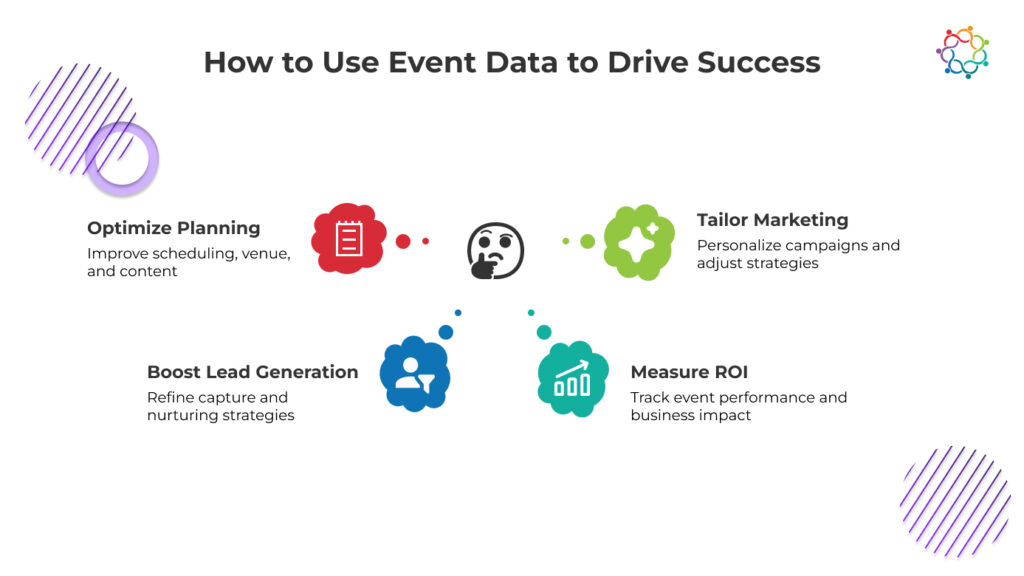
The insights gained from analyzing event data should directly influence your future event planning and marketing strategies:
Use attendee feedback and engagement data to improve logistics, from venue selection to session timing. Tailor your speaker lineup and content based on what resonated most with attendees.
Refine your lead capture strategies based on data insights. For instance, if QR codes outperformed manual forms, prioritize their use. Nurture leads more effectively by segmenting them based on quality and behavior.
Data-driven insights allow you to evaluate the performance of your marketing campaigns. Track which channels drove the most registrations and adjust your budget accordingly.
Data-driven event marketing is no longer optional—it’s essential. By collecting the right data, analyzing it effectively, and using insights to refine your strategies, you can create events that not only meet but exceed expectations.
Samaaro is designed to help you unlock the full potential of data-driven event marketing. With advanced data collection, analysis tools, and a seamless user experience, Samaaro makes it easy to measure success and optimize your efforts.
Ready to take your event marketing to the next level? Book a demo or start your free trial of Samaaro today, and discover how data can transform your events into unforgettable experiences.
Event marketing has entered a new era, where human connection and cutting-edge technology work in tandem to create truly transformative experiences. After years of rapid evolution, the resurgence of in-person events signals a profound shift in how we connect, communicate, and cultivate relationships. But in this new landscape, it’s not just about gathering people in a room; it’s about creating meaningful, memorable interactions.
This blend of human connection and data-driven insights is reshaping event marketing as we know it. Marketers are leveraging advanced tools to better understand their audiences while never losing sight of the power of face-to-face interactions. Let’s explore how these forces are shaping the future of event marketing and why they’re essential to your strategy.
At its core, event marketing has always been about people. The conversations, the handshakes, the shared laughter—all of these moments create bonds that can’t be replicated elsewhere. Human connection is the heart of every great event.
Even in today’s tech-savvy world, there’s something irreplaceable about meeting in person. Body language, tone of voice, and spontaneous discussions foster a sense of trust and understanding that digital communication simply can’t match. Whether it’s building rapport with potential clients or deepening relationships with existing partners, face-to-face interactions lay the foundation for long-lasting connections.
Events have the power to bring people together around shared goals, interests, or challenges. For businesses, this sense of community is invaluable. Attendees don’t just walk away with knowledge—they leave feeling a sense of belonging. And that’s what builds brand loyalty. By designing spaces and activities that encourage interaction, you create an environment where relationships can flourish naturally.
Great events don’t just inform; they engage the senses. From the aroma of fresh coffee to the buzz of a live performance, in-person events captivate attendees in ways that stick with them long after they leave. Sensory engagement leaves a lasting impression, turning your event into more than just a meeting—it becomes an experience.
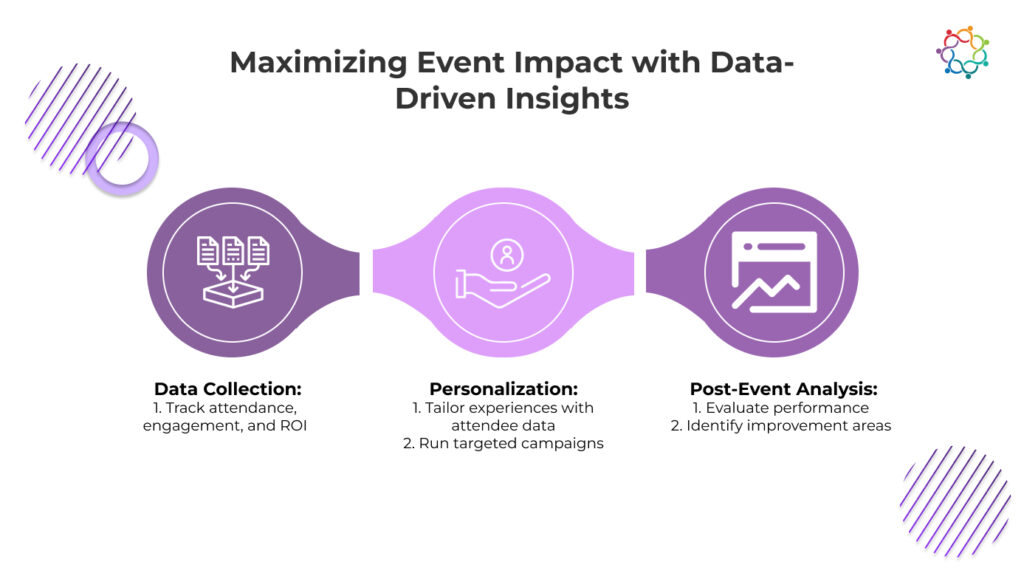
While human connection is at the heart of events, data is the brain. The ability to collect, analyze, and act on data has revolutionized event marketing, enabling businesses to create highly personalized and impactful experiences.
The first step in data-driven event marketing is identifying the metrics that matter most. Are you measuring attendance, engagement levels, or lead conversions? Perhaps ROI is your focus. With the right tools, collecting this data is easier than ever. Event technologies like mobile apps and check-in kiosks provide real-time insights, capturing everything from session participation to booth visits.
Once collected, this data becomes a goldmine for analysis. Patterns emerge, helping you understand what worked and what didn’t. Did a particular keynote draw more attendees than others? Was a certain booth more popular? With these insights, you can refine your approach for future events.
Today’s attendees expect more than cookie-cutter experiences—they want events tailored to their preferences. This is where data becomes invaluable. By analyzing attendee interests and behaviors, you can deliver personalized content, recommend sessions, or even suggest networking opportunities.
Imagine sending an attendee a custom agenda based on their industry or job role. Or suggesting breakout sessions that align with their professional goals. These small touches create a sense of value and make attendees feel seen and understood.
The work doesn’t stop when the event ends. Post-event analysis is critical to understanding your success and identifying areas for improvement. Attendee feedback, engagement metrics, and ROI calculations all come into play here.
Was your registration process smooth? Did attendees find the sessions valuable? Use these insights to continuously refine your strategy, ensuring each event is better than the last.
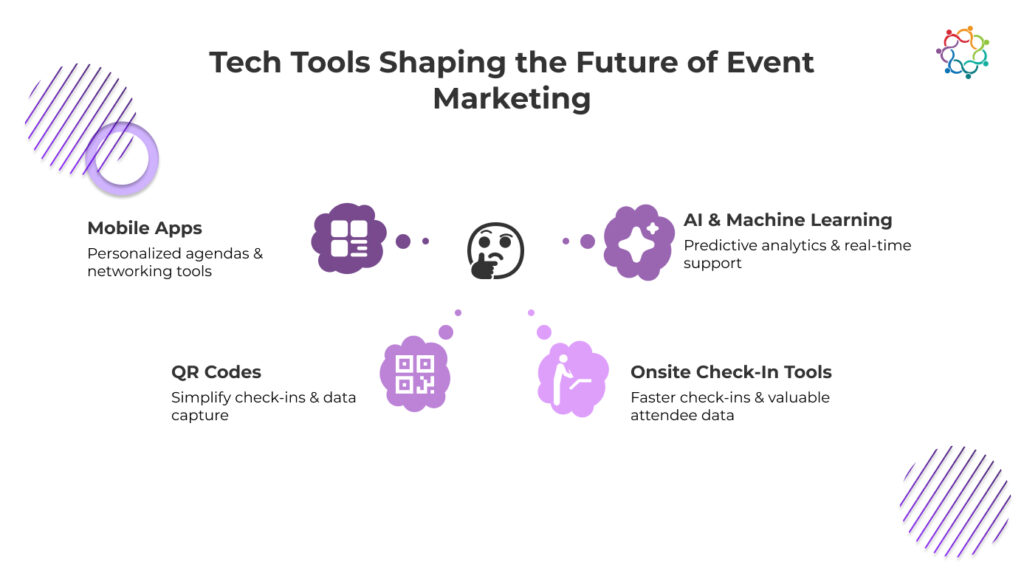
Technology is no longer an add-on for events; it’s a driving force behind their success. From streamlining operations to enhancing the attendee experience, the right tools can make all the difference.
Mobile apps have become indispensable in event marketing. They allow attendees to customize their schedules, receive real-time notifications, and even network with others—all at their fingertips. For organizers, apps provide a seamless way to collect data and deliver a more personalized experience.
Platforms like Samaaro take this a step further by enabling personalized agendas, helping attendees discover relevant sessions and activities effortlessly. These tools don’t just enhance convenience—they elevate the entire event experience.
Gone are the days of long registration lines and cumbersome processes. QR codes have streamlined check-ins, allowing attendees to breeze through with just a scan. Beyond registration, QR codes can also be used to capture leads, provide session access, and enable contactless sharing of information.
Efficient check-ins set the tone for the rest of the event. Onsite check-in tools not only speed up the process but also collect valuable data about attendees. This information can be used to personalize interactions, ensuring each guest feels welcomed and valued.
Artificial intelligence is transforming event marketing in exciting ways. Predictive analytics help organizers anticipate attendee needs, from room capacities to content preferences. Chatbots provide real-time support, answering questions and guiding attendees through the event. These technologies make events smarter, smoother, and more engaging.
The future of event marketing is all about balance—merging the timeless power of human connection with the precision of data-driven insights and technological innovation. By focusing on building relationships, creating memorable experiences, and leveraging the latest tools, marketers can deliver events that leave a lasting impact.
Samaaro stands at the forefront of this evolution, offering a comprehensive platform that combines personalization, engagement, and data analytics. Whether it’s streamlining operations, enhancing attendee experiences, or maximizing ROI, Samaaro empowers businesses to make every event a success.
Ready to elevate your event marketing strategy? Book a demo or start your free trial of Samaaro today, and experience the future of event marketing firsthand.
In today’s fast-paced digital landscape, businesses are constantly looking for innovative ways to improve their event ROI. Event technology, or event tech, has emerged as a game-changer, helping companies streamline operations, engage attendees, and most importantly, generate high-quality leads. But how exactly does event tech make this possible?
By leveraging advanced tools and features, event tech helps you not just collect leads, but also qualify and nurture them more effectively. Whether it’s through automated lead capture or personalized follow-ups, integrating event tech into your strategy can transform the way you connect with your audience.
Event technology refers to tools and platforms designed to streamline every aspect of event planning and execution, from registrations to post-event follow-ups. For lead generation, event tech acts as a bridge between attendees and businesses, ensuring that every interaction is meaningful and measurable.
Using event tech doesn’t just simplify the process; it enhances the quality of leads collected. Attendees’ preferences, behaviors, and interactions are tracked, providing invaluable data for personalized follow-ups. As a result, businesses can focus their efforts on nurturing high-potential leads, maximizing their return on investment (ROI).
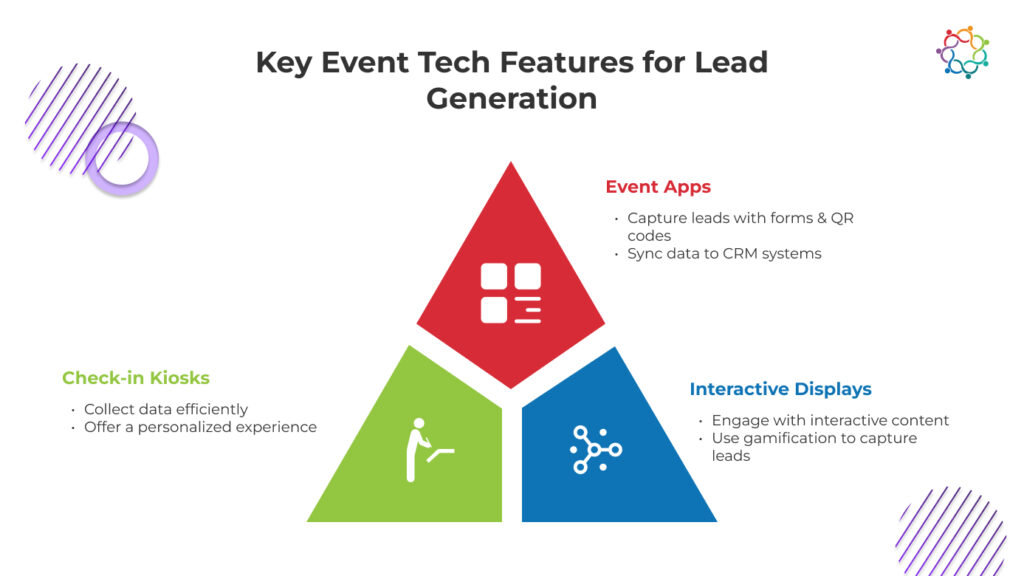
Let’s explore some event tech features that can transform your lead generation strategy:
Event apps are the Swiss Army knife of event tech. They offer multiple functionalities, all geared towards improving attendee experience and lead capture.
First impressions matter, and check-in kiosks set the tone for a seamless experience.
Interactive displays are not just eye-catching; they’re also incredibly effective at engaging attendees.
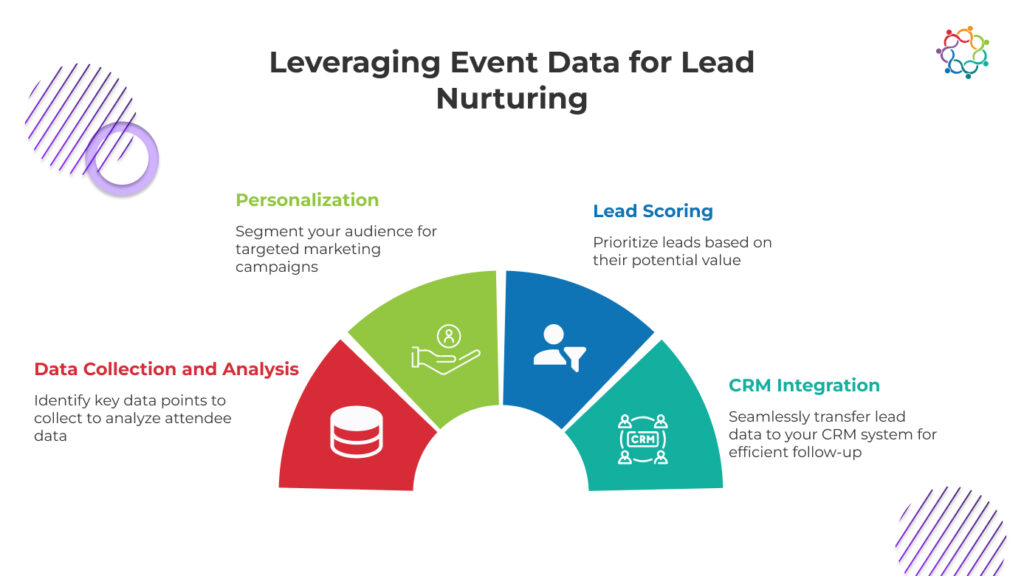
Collecting leads is just the beginning. The real magic happens when you use event data to nurture those leads into loyal customers.
To effectively nurture leads, you need to know as much as possible about them.
Generic follow-ups are a thing of the past. Today’s consumers expect tailored experiences.
Not all leads are created equal, and lead scoring helps you prioritize.
Efficiency is key in lead nurturing, and CRM integrations are your secret weapon.
Technology is only as effective as the strategy behind it. Here are some actionable tips to ensure you’re making the most of your event tech:
Location matters. Position your booths in high-traffic areas to maximize visibility. Think about the attendee flow and ensure your booth is easily accessible.
Draw attendees in with interactive displays, live demos, or mini-games. These not only create memorable experiences but also provide natural opportunities for lead capture.
Whether it’s “Sign Up for Exclusive Updates” or “Book a Demo Today,” your CTAs should be concise and enticing. Offering incentives like discounts or free resources can sweeten the deal.
The event might be over, but the lead generation process isn’t.
Event technology has become a cornerstone of successful lead generation, enabling businesses to collect high-quality data, nurture relationships, and convert opportunities into long-term growth. It’s no longer just about hosting events—it’s about creating memorable, data-driven experiences that leave a lasting impact.
Samaaro, as a leading event marketing platform, empowers you to do just that. With its suite of innovative features—seamless CRM integrations, interactive engagement tools, real-time analytics, and personalized communication capabilities—Samaaro helps you maximize your event’s potential while simplifying the process.
Why settle for average when you can create exceptional? Take the first step toward revolutionizing your event marketing strategy. Book a demo or start your free trial of Samaaro today, and discover how effortless lead generation and enhanced engagement can transform your business.
The world of real estate is evolving at an unprecedented pace, and technology has been a driving force behind this transformation. From property tours to predictive analytics for investment decisions, the industry is rapidly embracing cutting-edge tools to enhance its marketing strategies. One area where technology is making a particularly significant impact is in event marketing. As real estate events become more complex, there’s an increasing need for smarter, data-driven strategies. Enter AI and machine learning—two powerful technologies that are poised to revolutionize how real estate professionals approach event marketing.
By harnessing the capabilities of AI and machine learning, real estate professionals can create more effective, personalized, and data-driven event marketing campaigns. These technologies allow for the automation of mundane tasks, deeper insights into attendee behavior, and highly targeted marketing efforts, all of which can dramatically improve the success of real estate events.
Understanding AI and Machine Learning
Before diving into how AI and machine learning can reshape real estate event marketing, let’s quickly define these technologies.
In real estate event marketing, these technologies are applied to enhance personalization, streamline event planning, and predict outcomes—all while providing real-time insights that can optimize the entire event lifecycle.
AI-Powered Event Planning and Management
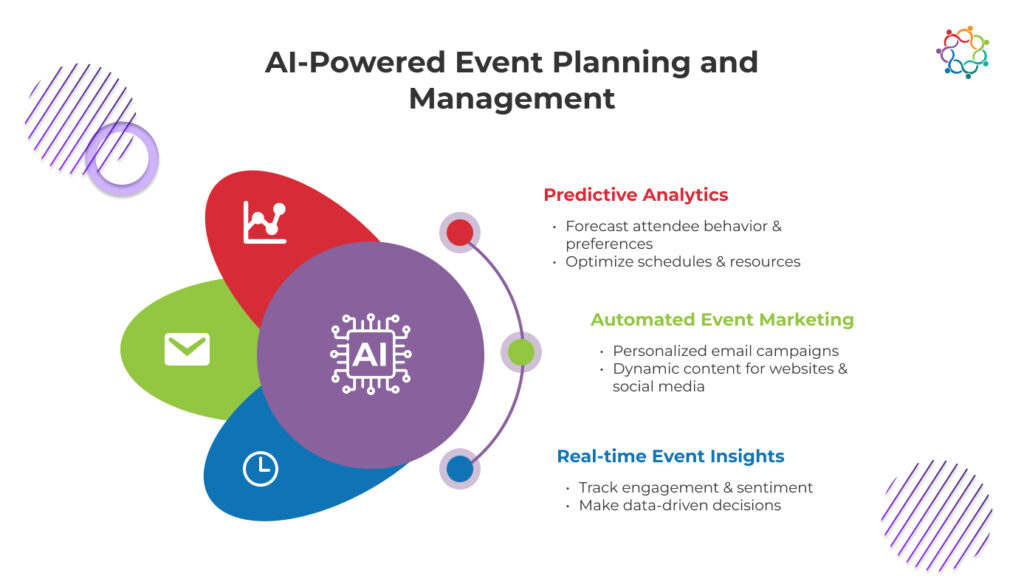
Event planning can be a challenging, time-consuming process, but AI simplifies it by offering data-driven insights that can optimize every aspect of the event.
1. Predictive Analytics
One of the most powerful ways AI can transform real estate event marketing is through predictive analytics. By analyzing past event data, AI can forecast attendee behavior and preferences. For instance, it can predict which sessions attendees are most likely to attend, what type of content will resonate with different groups, or even which speakers or exhibitors will draw the most interest. These insights allow real estate professionals to plan events more strategically, ensuring that they allocate resources effectively and optimize event schedules.
Predictive analytics can also forecast demand for specific event activities or product showcases, helping organizers to better manage logistics and resources in advance.
2. Automated Event Marketing
AI can automate many aspects of event marketing, making it easier for organizers to reach their target audience at scale. Personalized email campaigns, for instance, can be crafted based on individual preferences, behaviors, and demographics, ensuring that each attendee receives tailored content that speaks directly to their needs.
In addition to email marketing, AI can dynamically generate content for event websites and social media channels. Whether it’s adjusting event descriptions, updating speaker bios, or sharing targeted ads, AI ensures that the content resonates with the right audience at the right time.
3. Real-Time Event Insights
During an event, it’s crucial to stay on top of how attendees are engaging with different sessions, speakers, and experiences. AI provides real-time insights into attendee sentiment, engagement levels, and behavior. With tools that track social media mentions, survey responses, and event app interactions, AI can help organizers understand how attendees are feeling at any given moment. This data can be used to make on-the-spot adjustments to improve attendee experiences—whether it’s tweaking a session’s content or adding more networking opportunities based on attendee interest.
Leveraging Machine Learning for Personalized Event Experiences
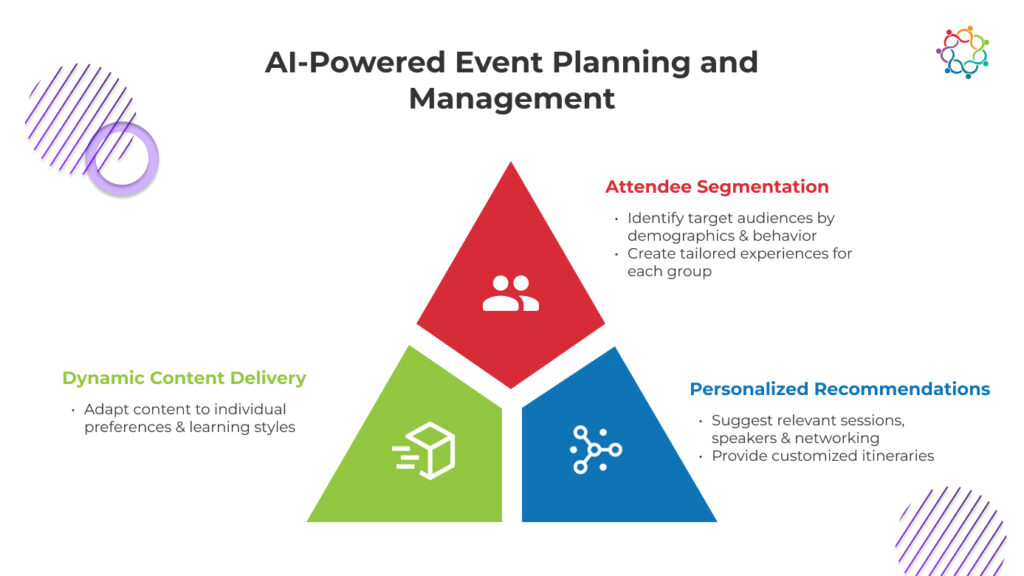
Machine learning further enhances personalization by analyzing attendee data to create more targeted and meaningful experiences. Through advanced algorithms, real estate professionals can offer customized event journeys for each participant, making every interaction feel unique and highly relevant.
1. Attendee Segmentation
Machine learning can process large amounts of data to identify specific audience segments based on demographics, preferences, and behaviors. Whether you’re targeting first-time homebuyers, seasoned investors, or luxury real estate enthusiasts, machine learning can help you segment attendees in a way that ensures each group receives the most relevant content.
By understanding attendee motivations and interests, event organizers can offer tailored event experiences that resonate deeply with each segment, increasing overall engagement and satisfaction.
2. Personalized Recommendations
Machine learning can also make personalized recommendations for attendees. Imagine an event app that suggests relevant sessions, speakers, or networking opportunities based on each attendee’s preferences or past behavior. With machine learning, you can offer real-time recommendations that guide participants to the most valuable experiences.
This level of personalization can significantly improve attendee satisfaction, as people feel their time is well-spent, and their individual needs are met.
3. Dynamic Content Delivery
Machine learning algorithms can adapt content delivery to suit individual preferences. For example, during a virtual or hybrid event, the platform can tailor session formats—whether video, text, or interactive elements—based on attendee preferences. By doing so, attendees are more likely to engage with the content, leading to a more impactful event experience.
The Role of Event Technology Platforms
While AI and machine learning offer significant potential, leveraging these technologies effectively requires a powerful event technology platform. Event management and marketing platforms play a crucial role in integrating AI and machine learning tools to streamline event planning, enhance engagement, and measure event performance.
1. Samaaro: A Comprehensive Event Marketing Solution
Samaaro is an all-in-one event marketing that integrates both AI and machine learning capabilities. It offers real estate professionals a comprehensive solution for planning, executing, and optimizing their events—from the early planning stages to post-event analytics.
Samaaro leverages AI-powered tools for predictive analytics, real-time event insights, and personalized content delivery, making it easier for real estate organizers to connect with their audiences in meaningful ways. Additionally, the platform offers advanced event marketing tools that allow you to segment attendees, automate email campaigns, and generate dynamic content for your website and social media.
Beyond event marketing, Samaaro also serves as an event management platform, streamlining everything from registration and attendee management to on-site operations and post-event analysis. This holistic approach ensures that every aspect of your real estate event is optimized for success.
2. Event Management and Marketing Integration
Samaaro’s seamless integration of event management and marketing tools provides a unified approach to real estate event success. It allows you to manage your entire event lifecycle in one platform—saving time, reducing complexity, and enhancing overall event performance. Samaaro ensures your audience receives a personalized, engaging experience, while providing you with the insights and tools you need to drive ROI.
Conclusion
The integration of AI and machine learning into real estate event marketing represents a transformative opportunity for the industry. These technologies enable personalized experiences, predictive insights, and data-driven decisions that enhance the overall success of real estate events. By adopting these tools, real estate professionals can create more impactful and efficient marketing campaigns, ultimately driving greater engagement and ROI.
Samaaro is at the forefront of this transformation, offering a comprehensive platform that combines both event marketing and event technology to optimize the entire event lifecycle. Ready to take your real estate events to the next level? Try a free trial or book a demo with Samaaro to discover how our AI-powered platform can help you optimize event marketing, engage attendees more effectively, and measure your event success in real-time.
Continuing Medical Education (CME) plays a crucial role in ensuring that healthcare professionals stay updated with the latest medical advancements and enhance their clinical skills. However, as the healthcare sector faces budget constraints and increasing demand for effective professional development, the need for cost-effective and impactful CME events has never been greater. Whether in-person, virtual, or hybrid, healthcare organizations must optimize the return on investment (ROI) of their CME events to ensure they deliver meaningful value for both attendees and the organization itself.
By implementing strategic planning and leveraging advanced technology, healthcare organizations can maximize the ROI of their CME events, ensuring that every dollar spent results in measurable benefits. Here’s how you can achieve that.
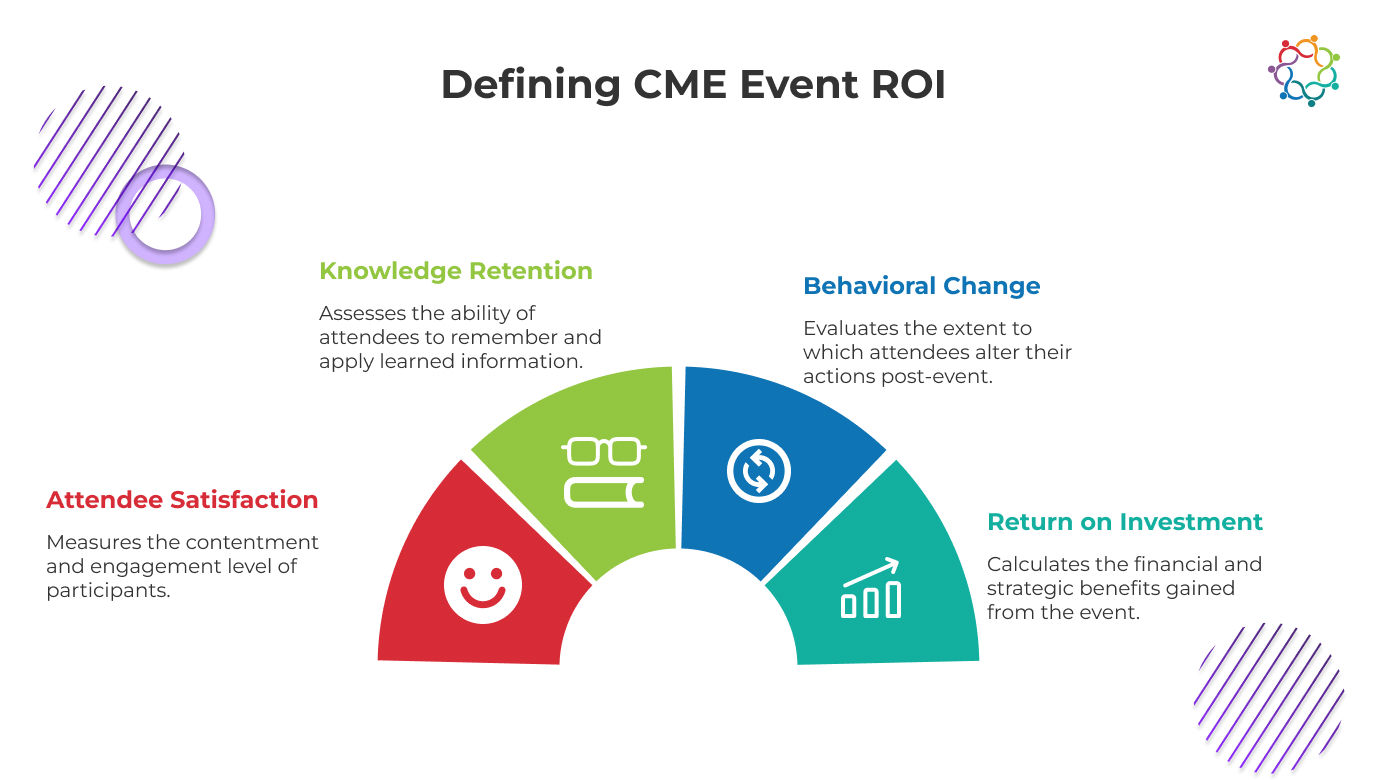
ROI is not just about the financial outcome of an event—it’s about the long-term benefits that CME events bring to healthcare professionals, the organization, and even patient care. Key metrics to assess CME event success include:
While measuring ROI for CME events is essential, it comes with its challenges. Traditional methods often focus on quantitative outcomes, such as the number of attendees or the immediate feedback received, but these alone fail to capture the full impact of the event. The real ROI is seen when you track how attendees apply the knowledge gained to improve patient care or advance their careers.
To truly optimize CME event ROI, healthcare organizations must adopt a strategic approach from the outset. Here are a few key strategies:
Understanding the target audience’s needs is the foundation of any successful CME event. By conducting surveys or interviews before the event, healthcare organizations can identify the specific learning goals of attendees and align the content with their professional development requirements. This personalized approach ensures that the event will be relevant and impactful for each participant.
Allocating resources effectively is crucial to ensuring a high ROI. Identifying cost-saving strategies, such as leveraging in-house expertise or partnering with sponsors, can help minimize expenses. Efficiently managing budgets also involves focusing on the areas that will have the highest impact—whether it’s quality speakers, interactive content, or effective event technology.
Choosing the right event format (in-person or hybrid) can significantly affect your ROI. In-person events offer networking opportunities and hands-on learning but come with higher costs. Hybrid events, on the other hand, can offer greater accessibility and scalability, though they require sophisticated technology to engage attendees effectively. The right format should be selected based on your objectives, target audience, and available resources.
Technological tools like Event Management Software, Learning Management Systems (LMS), play a vital role in optimizing event ROI. These tools streamline event management, improve engagement, and enable personalized learning paths for attendees.
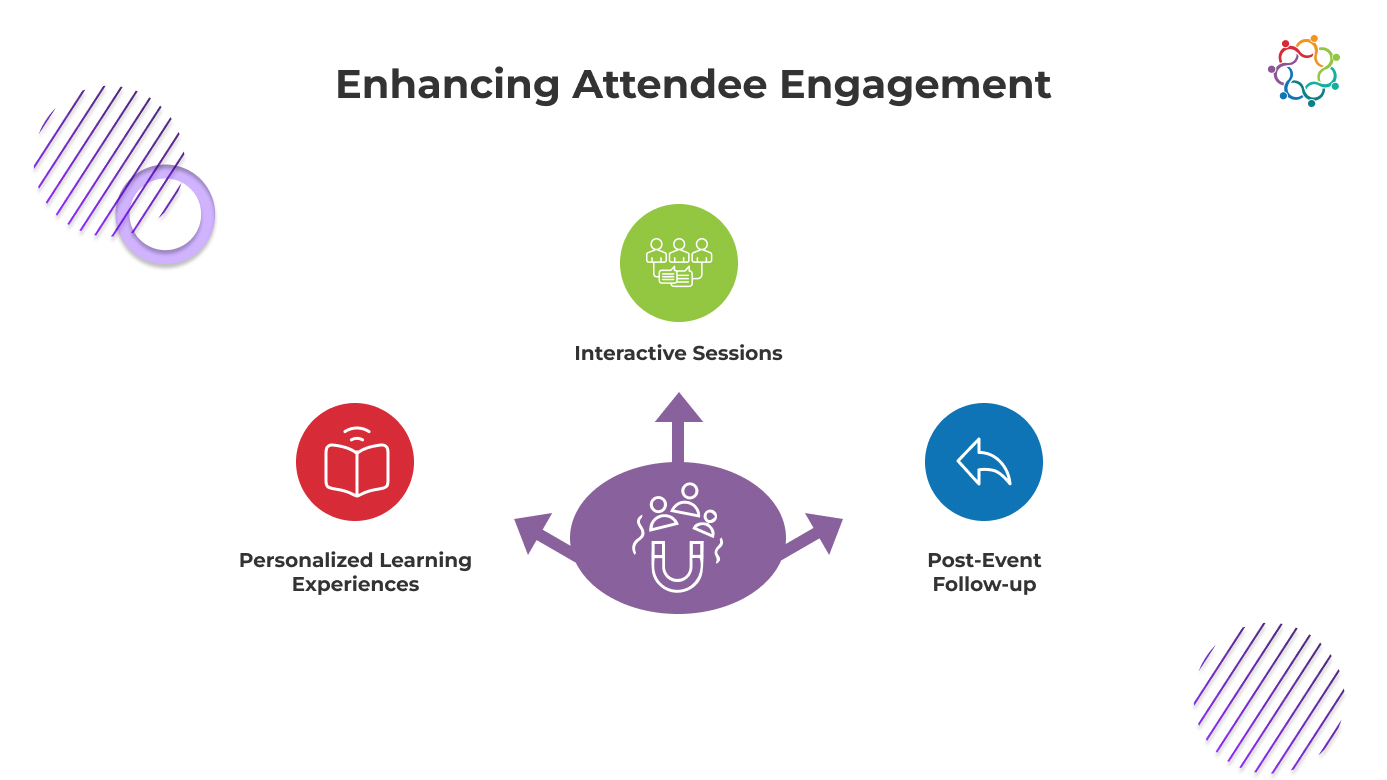
Active participation is key to ensuring knowledge retention and maximizing the ROI of any CME event. Healthcare organizations can boost engagement by offering a variety of interactive elements:
Case studies, group discussions, and hands-on workshops enable attendees to apply what they’ve learned in a practical, real-world context. Additionally, incorporating gamification elements such as quizzes, leaderboards, and challenges helps maintain engagement and incentivizes learning.
One-size-fits-all training sessions rarely work in healthcare. By tailoring the content to individual needs, such as offering on-demand content and self-paced learning options, organizations ensure that every participant can engage in a way that suits them best.
The learning doesn’t stop when the event ends. Offering post-event resources, continuing education opportunities, and networking can extend the impact of the CME event and ensure long-term engagement. Follow-up surveys are an effective way to measure attendee satisfaction, gather feedback, and identify areas for improvement.
To truly understand the effectiveness of CME events, healthcare organizations must track a combination of pre- and post-event metrics:
A baseline assessment helps measure attendees’ knowledge and skills before the event. This sets a benchmark for measuring knowledge retention and behavioral change.
After the event, knowledge retention tests, behavioral change surveys, and attendee satisfaction surveys provide crucial insights into how well the event achieved its objectives.
Tracking long-term outcomes, such as career advancements and improvements in patient care, can help organizations evaluate the true impact of their CME events. This analysis is vital for refining future event strategies.
Using a specialized event marketing platform like Samaaro is essential for optimizing CME event ROI. Samaaro provides the tools necessary to streamline the entire event process, from planning to post-event analysis.
Optimizing the ROI of CME events requires a strategic approach that incorporates effective planning, personalized learning experiences, and the right technology. By focusing on key performance metrics such as attendee satisfaction, knowledge retention, and long-term impact, healthcare organizations can ensure that their CME events deliver substantial value to participants and the organization.
As the healthcare industry continues to prioritize professional development, embracing technology and tools like Samaaro can significantly enhance the value of CME events. Ready to take your CME events to the next level? Try a free trial or book a demo with Samaaro to discover how our platform can help optimize your CME event ROI and create lasting impact.
Storytelling has become an essential element in marketing—especially in the realm of high-net-worth individual (HNI) events, where meaningful experiences matter most. At its core, storytelling doesn’t just deliver information; it evokes emotions, sparks connections, and creates memories that resonate long after an event ends. When applied to HNI-focused events, storytelling transforms the experience, making clients feel like a part of something unique and memorable.
Creating these impactful stories for HNI clients goes beyond showcasing products or services. It’s about designing experiences that reflect their aspirations, values, and preferences. With a thoughtful approach to storytelling, wealth management firms can create events that genuinely speak to the hearts of their clients, building trust, loyalty, and long-term relationships.
Understanding the HNI Audience
HNI clients often have expectations that go beyond what conventional event marketing can fulfill. They seek exclusivity, personalization, and unique experiences that reflect their lifestyles and values. For them, attending an event is not merely about information or networking—it’s about being part of something that aligns with their refined tastes and passions.
The key to crafting event narratives for HNIs is understanding what drives them emotionally. For instance, their sense of accomplishment, legacy, and appreciation for quality can serve as powerful emotional triggers. A carefully tailored narrative can tap into these values, making attendees feel that the event speaks to their identity and values.
The Art of Storytelling in Event Marketing
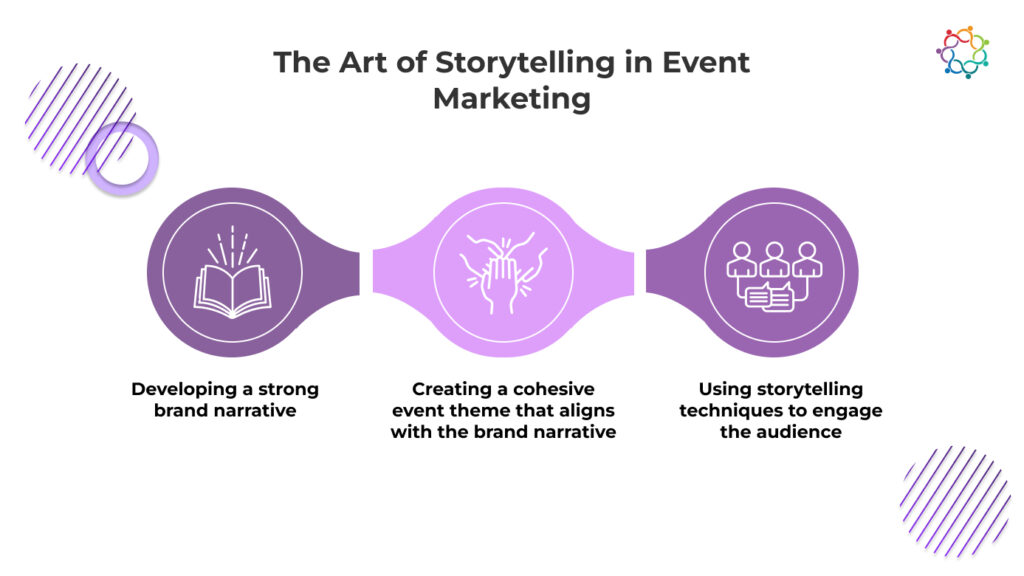
In event marketing, storytelling is about crafting a narrative that intertwines with the event’s theme, activities, and setting. Here are a few popular storytelling techniques that can elevate an HNI-focused event:
1. The Hero’s Journey
This classic story framework portrays the client or attendee as the hero, embarking on a journey of transformation. From entering the event to engaging in exclusive sessions and experiences, each stage of the event can represent a part of their journey, culminating in a memorable “aha” moment.
2. The Villain’s Journey
In this approach, the “villain” could be represented as a challenge or obstacle that clients face in their lives or industries. For example, an event might position itself as the answer to overcoming economic volatility, with each session or keynote helping attendees conquer this shared “villain” and emerge more empowered.
3. The Rags-to-Riches Story
This narrative style works well for events focused on growth, wealth, and achievement. It’s especially impactful when showcasing success stories or case studies that resonate with attendees’ own journeys. Sharing inspiring stories from peers or showcasing how certain strategies led to significant transformations can create aspirational yet relatable moments.
A well-crafted story theme is essential, but it should also be woven into every aspect of the event—decor, lighting, activities, even the menu. The more cohesive the story, the more immersive and impactful the experience will be.
Leveraging Event Marketing Platforms to Enhance Storytelling
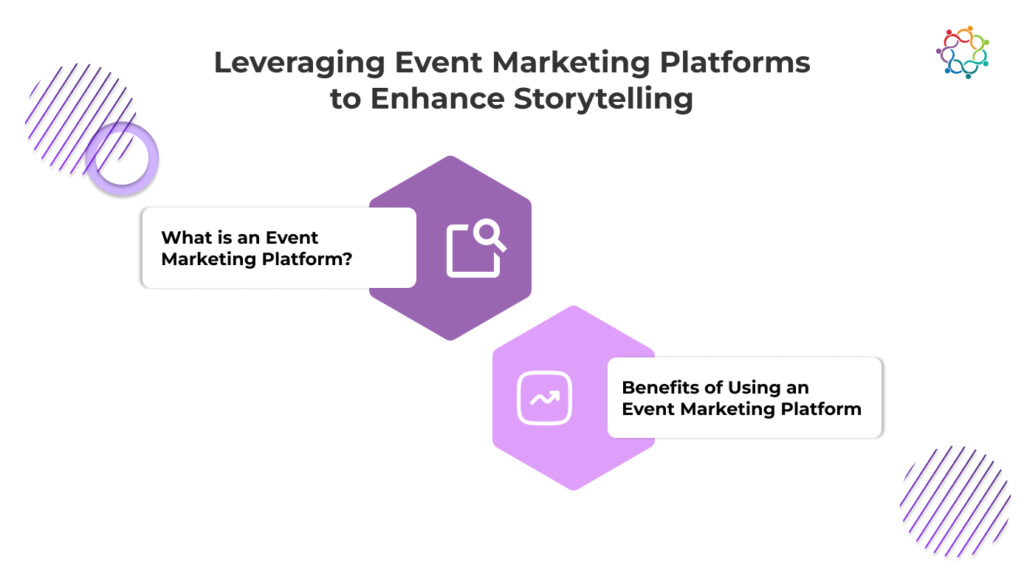
Event marketing platforms like Samaaro make it easier to bring these narratives to life. By using these platforms, wealth management firms can create a seamless experience that aligns with their storytelling goals, from the moment a client RSVPs to the post-event follow-ups.
1. What is an Event Marketing Platform?
An event marketing platform is a comprehensive tool that supports event planning, execution, and analysis. With features like registration management, attendee engagement, and data analytics, these platforms allow marketers to craft cohesive event experiences that align with their brand’s story.
2. Benefits of Using an Event Marketing Platform
a. Streamlining Event Planning and Execution: Platforms like Samaaro make event planning easy by centralizing details like registrations, agendas, and attendee preferences. This allows event organizers to focus on personalizing the experience rather than managing logistics.
b. Enhancing Attendee Engagement: With the right tools, it’s easier to tailor experiences for each attendee. For example, you can send personalized invitations, offer curated agendas, or even allow guests to customize their own event schedules, enhancing engagement.
c. Measuring Event ROI and Tracking Key Metrics: Event marketing platforms provide real-time data and analytics, making it easy to track engagement, attendance, and feedback. By analyzing these metrics, organizers can see which parts of the story resonated most with clients and refine their strategies for future events.
3. Popular Event Marketing Platforms
Event platforms such as Samaaro provide diverse options for enhancing storytelling and engagement at events. Each offers unique features that support a range of event goals, from audience engagement to detailed analytics.
Creating Memorable Event Experiences
A compelling narrative is only part of the experience—creating memories that last requires attention to sensory details and emotional moments. Immersive experiences tap into all five senses, making attendees feel as though they’ve stepped into another world. For example, you might use visual elements that reflect the event theme, such as luxury decor for an event centered on wealth and achievement. Adding sensory components—like fragrance, ambient sounds, and tactile textures—further enhances the experience, creating a fully immersive environment.
Technology can also play a crucial role in elevating the event. From tours of exclusive properties to interactive displays that share personal client success stories, technology bridges the gap between concept and experience, making storytelling a shared, impactful journey.
Measuring the Impact of Event Narratives
Measuring the success of storytelling in events is about more than numbers; it’s about assessing whether the story resonated and had a lasting impact on attendees. Here are a few metrics to consider:
1. Attendee Satisfaction
Collect feedback from attendees to see if the story and event theme resonated. Surveys, feedback forms, and interviews can provide direct insight into what attendees loved—and what could be improved.
2. Social Media Engagement
Track engagement on social media channels, including mentions, likes, shares, and comments. Social media buzz is a valuable metric, indicating how well the story resonated and how far it spread beyond the event itself.
3. Lead Generation and Sales Conversions
Track the number of leads generated and the conversions that result from them. A well-crafted narrative can drive interest and motivation, resulting in more attendees wanting to learn about products or services.
4. Brand Awareness
A successful event narrative can amplify brand awareness. Attendees who connect with the event’s story are more likely to remember the brand, refer it to others, and engage with future events.
Analytics tools within event platforms, like Samaaro, make it easy to track these metrics and determine what worked well, allowing for constant refinement and improvement in event strategy.
Conclusion
Crafting compelling event narratives isn’t just about enhancing HNI events—it’s about creating connections that leave a lasting impact. For wealth management firms, investing in storytelling at events can be transformative, fostering relationships built on shared experiences and memorable moments.
As the future of event marketing continues to evolve, storytelling will remain a vital tool for resonating with HNI clients. When combined with technology and platforms like Samaaro, it’s easier than ever to craft unforgettable narratives that enhance attendee engagement and satisfaction.
Ready to see how storytelling can elevate your next HNI event? Try a free trial or book a demo with Samaaro to discover how our platform can bring your vision to life.
Continuing Medical Education (CME) events are essential for healthcare professionals, providing opportunities to deepen knowledge, gain new skills, and stay updated on advancements in their field. However, a major challenge in CME is keeping participants actively engaged. Traditional passive learning methods, like lectures, often leave attendees disengaged and struggling to retain the information.
Active learning can be a game-changer here. By introducing interactive elements into CME events, organizers can transform the experience, making it engaging and impactful. Interactive learning strategies are not only proven to boost knowledge retention but also help participants apply new insights more confidently in their practice. With a thoughtful approach, healthcare organizations can create CME events that spark engagement, drive learning, and leave lasting impressions on attendees.

Real-life cases resonate with healthcare professionals because they closely mirror the challenges they face every day. Case-based learning involves diving into real-world scenarios where participants work in groups to solve complex problems. Discussions become lively as people share their insights and strategies, learning from each other in the process.
Beyond just theory, this method emphasizes practical problem-solving skills. Attendees gain feedback from peers and facilitators, helping them see different perspectives and broadening their understanding. Case-based learning makes CME events highly interactive, helping participants connect with content in a way that’s immediately relevant to their work.
In a field where precision and skill matter, role-playing simulations offer an immersive way to practice clinical techniques in a safe environment. Attendees can try out various procedures or handle simulated patient interactions, gaining confidence and expertise with hands-on experience.
Role-playing scenarios also provide immediate feedback from experienced professionals, allowing participants to understand and correct mistakes instantly. These exercises often spark valuable discussions, helping attendees learn not only from the instructors but from each other’s approaches. This type of learning makes CME events memorable and ensures that participants walk away with skills they feel confident applying in real situations.
Introducing game-like elements to CME events adds an element of fun and motivation. Through gamified quizzes, challenges, and leaderboards, attendees are encouraged to engage more actively. The competitive aspect of gamification drives attention and enthusiasm, as participants strive to achieve high scores or complete challenges.
Gamified experiences allow attendees to test their knowledge in a low-stakes environment and receive instant feedback. This strategy keeps participants engaged, makes learning enjoyable, and reinforces key concepts effectively.
Hands-on workshops offer attendees the opportunity to dive deep into specific skills, techniques, or new technologies. These labs are highly collaborative, encouraging group activities where participants can practice together, share insights, and assist each other.
In interactive labs, attendees are not just passive listeners—they’re part of a dynamic learning environment. Working in groups helps build a sense of camaraderie and creates an environment where learning feels like a team effort. Attendees can directly apply what they’ve learned, making it far more likely that they’ll remember and use these skills post-event.

Event apps have transformed the way attendees interact and engage during CME events. With real-time polling, surveys, and Q&A sessions, attendees can provide feedback on sessions instantly. Event apps also enable interactive agendas and networking opportunities, making it easy for attendees to find sessions of interest and connect with peers.
By using event apps like Samaaro, organizers can streamline these interactions, allowing for a seamless experience that enhances engagement without taking away from the event itself.
An LMS allows organizers to offer additional learning resources and assessments online, extending the event’s impact beyond just the event days. Online quizzes and personalized learning paths make learning more structured, ensuring attendees have access to a robust follow-up curriculum. This type of system is invaluable for long-term learning, where attendees can revisit material and strengthen their understanding.
Tools for live polling, Q&A, and collaborative note-taking make presentations far more engaging. Attendees can ask questions in real-time, participate in discussions, and respond to polls to gauge the room’s opinions on various topics. These tools make sessions dynamic and interactive, keeping participants engaged and allowing presenters to adapt based on the audience’s responses.
To gauge the effectiveness of interactive learning strategies, pre- and post-event assessments are invaluable. By comparing attendees’ knowledge and skills before and after the event, organizers can directly measure learning outcomes.
Gathering feedback helps organizers understand how well the interactive elements resonated with attendees. Surveys and evaluations give insight into what worked well and what could be improved. Honest feedback is essential for refining future events and maintaining high standards of attendee satisfaction.
The ultimate goal of CME events is for participants to implement new knowledge and skills in their clinical practice. Tracking how attendees apply what they learned can be done through follow-up surveys or feedback from employers. Behavioral change is a powerful metric that speaks to the true impact of the event.
As CME events evolve, the shift towards interactive learning is redefining the way healthcare professionals engage with content and each other. By incorporating interactive elements, healthcare organizations can foster a learning environment that promotes engagement, enhances knowledge retention, and creates meaningful experiences.
Investing in high-quality CME events isn’t just about meeting educational requirements; it’s about creating learning moments that professionals carry forward in their practice. The future of CME is interactive, immersive, and technology-driven, and event tech platforms like Samaaro make this transformation seamless and effective.
Experience the power of interactive CME events firsthand—sign up for a Free trial or book a demo with Samaaro today to see how experiential learning can elevate your CME event and drive long-lasting engagement.
In today’s dynamic real estate landscape, marketing strategies have to work harder than ever. With countless listings online and numerous developers competing for the attention of brokers, agents, and potential buyers, simply showcasing a property’s features may no longer be enough. Traditional marketing tactics like brochures, billboards, and static websites often fall short in creating an emotional connection with potential clients.
Experiential marketing is emerging as a transformative approach in real estate marketing, bringing with it the power to create unforgettable, immersive experiences that connect deeply with brokers, agents, and buyers alike. This blog delves into why experiential marketing is likely to become the future of real estate marketing and how developers can use this strategy to build relationships that drive long-term value.
Understanding Experiential Marketing
Experiential marketing is all about creating impactful, memorable experiences. Unlike traditional marketing, which typically focuses on delivering messages to a broad audience, experiential marketing aims to engage clients in interactive and personalized ways. The goal is to build an emotional connection that not only showcases the property but also leaves a lasting impression.
In real estate, this might mean offering property tours, hosting VIP launch events, or even creating pop-up showrooms. Experiential marketing is about fostering a genuine connection by making clients part of the experience rather than just observers.
Leveraging Experiential Marketing for Real Estate Developers
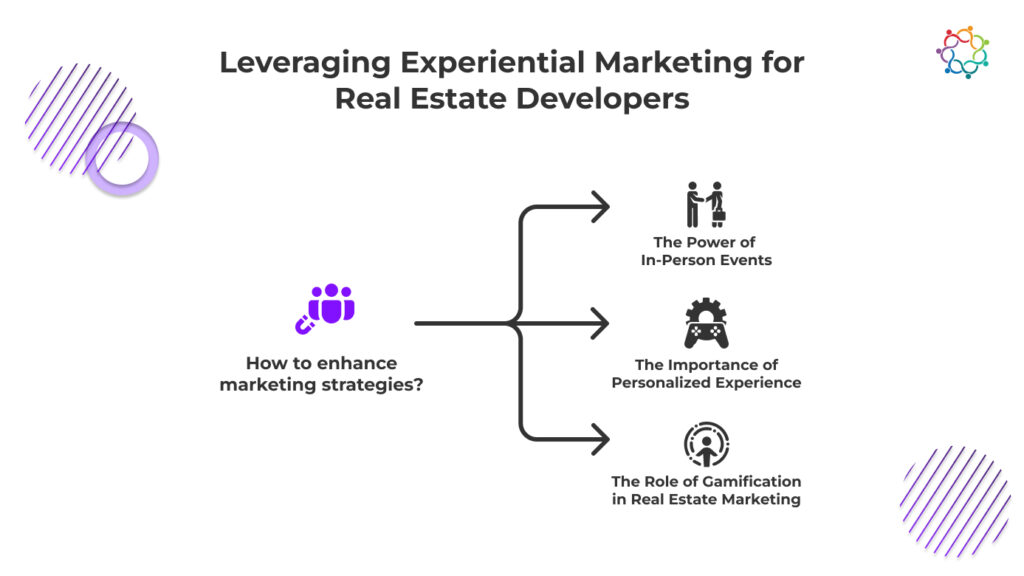
The Power of In-Person Events
In-person events are invaluable in real estate. Whether it’s a luxury launch event or an exclusive viewing, these events can make clients feel valued and provide a tangible sense of the property. From interactive installations to themed spaces that highlight the lifestyle a property offers, events can go far beyond simply presenting specs and pricing.
Using platforms like Samaaro, real estate developers can streamline the entire event process, from planning and promotions to on-site attendee management. These platforms offer easy solutions for managing RSVPs, tracking attendance, and collecting feedback, which allows for a seamless and impactful event experience.
The Importance of Personalized Experiences
Real estate professionals understand that brokers, agents, and clients each have unique needs. Tailoring experiences to meet these specific interests can be a game-changer. Personalized consultations, for instance, provide a chance for agents to discuss potential offerings in detail, catering to specific buyer interests like sustainability, luxury amenities, or community features. Personalization also extends to post-event follow-up, where tailored insights and property details help reinforce connections.
The Role of Gamification in Real Estate Marketing
Gamification—using interactive games or challenges to engage attendees—is an increasingly popular tactic in experiential marketing. For instance, real estate developers could incorporate a property scavenger hunt during open houses, where participants unlock features by visiting different parts of the property. This can incentivize exploration and make the experience memorable.
Gamification doesn’t just add fun; it encourages engagement and learning in a way that’s both effective and enjoyable. This approach not only makes the experience interactive but also reinforces property features that might otherwise be overlooked.
Measuring the ROI of Experiential Marketing
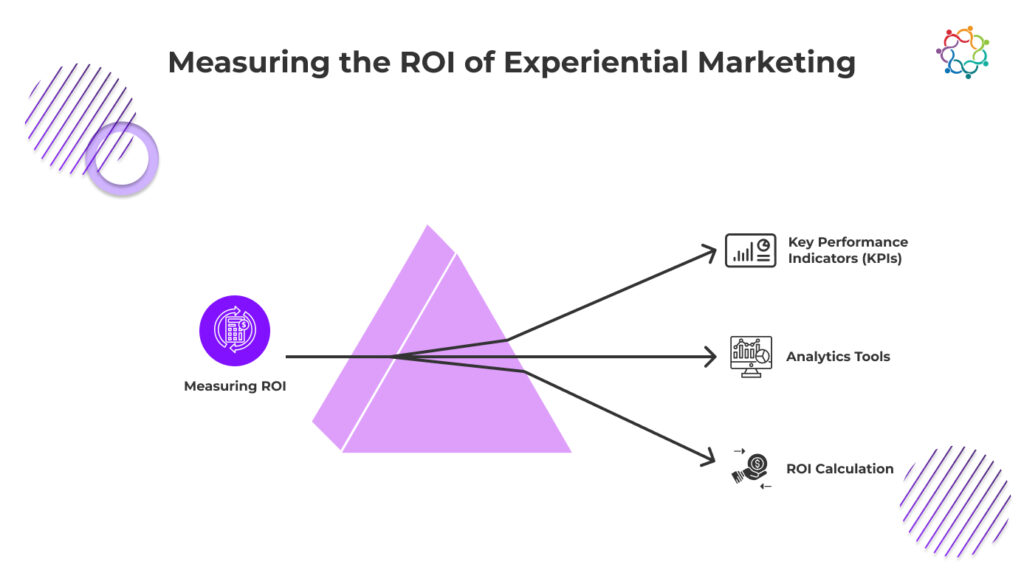
When investing in experiential marketing for real estate, measuring the return on investment (ROI) is essential to understand the campaign’s success and impact. To evaluate ROI effectively, real estate developers should focus on specific key performance indicators (KPIs) that give insights into event success, attendee engagement, and overall brand growth.
Key Performance Indicators (KPIs) for Real Estate Events
Using Analytics Tools to Track Event Performance
To gather and analyze these KPIs effectively, consider utilizing analytics tools within event marketing platforms, such as Samaaro, to capture real-time data and visualize it in reports. These platforms can track attendee engagement metrics, session participation, social media interactions, and more. By consolidating event data into one platform, you can better understand how attendees interacted with the content, which elements were most effective, and where there might be gaps in engagement.
Calculating the Return on Investment (ROI) of Experiential Marketing Campaigns
Finally, calculating ROI requires comparing the event’s costs (venue, materials, staffing, etc.) against the tangible and intangible benefits gained, like leads generated, sales closed, and brand lift. ROI can be calculated using a straightforward formula:
ROI?=?(Net?Profit?From?Event???Event?CostsEvent?Costs)×100ROI?=?Net?Pr?ofit?From?Event???Event?CostsEvent?Costs×100
Analyzing ROI helps real estate developers decide which types of experiential events offer the highest returns and which strategies might need adjustment for future campaigns. This data-driven approach not only strengthens the case for experiential marketing but also allows developers to fine-tune their tactics for maximum impact.
Conclusion
Experiential marketing holds tremendous promise for the future of real estate. By creating meaningful, engaging, and personalized experiences, real estate developers can foster stronger relationships with brokers, agents, and clients alike. High-quality events and immersive experiences are not only memorable but also drive tangible results in terms of brand loyalty and sales.
For real estate professionals ready to explore innovative marketing strategies, now is the time to take the leap. As the real estate market continues to evolve, experiential events will likely play an increasingly crucial role in building brand trust and loyalty.
To discover how Samaaro’s powerful event marketing tools can help bring your vision to life, start a Free Trial or Book a Demo today. The future of real estate marketing is here, and with the right strategies and tools, it’s full of exciting possibilities.
Experiential marketing—creating immersive, memorable experiences to connect with clients on a deeper level—is fast becoming a key tool for businesses, especially when targeting High Net Worth Individuals (HNIs). HNIs aren’t just looking for another transaction; they value exclusivity, personal touch, and meaningful experiences. For wealth management firms, hosting events designed with their unique expectations in mind offers an incredible opportunity to build lasting relationships.
By investing in high-quality, personalized experiences, firms can go beyond just promoting services—they can truly connect with HNIs on an emotional level, laying the foundation for strong, long-term client loyalty.
The Power of Personalized Experiences
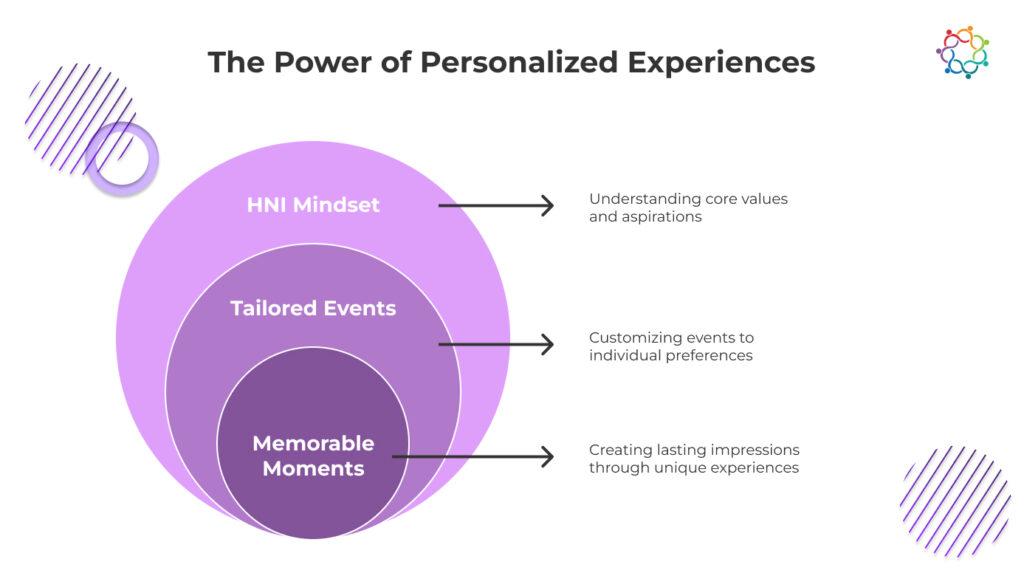
Understanding the HNI Mindset
HNIs possess individual distinctions when it comes to preferences and motivations. HNIs typically make decisions based on a mixture of exclusivity, quality, and value. They’re not just looking for luxury, they’re looking for meaning, connection, and memorable experiences. Wealth managers who comprehend this can arrange events that are not sales-driven but naturally connect to guests.
Creating Tailored Events
A personal experience means gathering insightful information about clients personal preferences, tastes, interests, and likes. One client may enjoy an intimate wine tasting, while another client may enjoy a more public art exhibition. Events that use event technology, like Samaaro, allow managers to integrate a personal touch right from the invitation. Anything from the design, theme/branding, and agenda preview can be designed specifically and personally to fit each guest’s profile. Samaaro and other event tech platforms allow a stranger to brand, design, and utilize a very personal approach before they even step foot into a room.
Create Experiences that Last
Perhaps more than anything else, however, standing out is also dependent on creating moments guests will never forget. Sensory experiences like music, lighting, and scent will set a simple meeting apart from a noteworthy event. A specific theme tailored for your gathering like an art that has been curated, or a lasting experience will help guests to ultimately remember this meeting, particularly because HNIs typically enjoy special, sometimes exclusive, events.
Leveraging Event Technology to Enhance Engagement
Event Marketing Platforms
Event technology allows wealth management firms to scale personalized experiences while maintaining a high level of attention to detail. Platforms like Samaaro offer real-time engagement tools and AI-driven recommendations, making it easy to tailor content and event flow to suit each high-net-worth individual’s (HNI) preferences. By automating aspects of event management, wealth managers can focus on what truly matters—building genuine, face-to-face connections with attendees.
Personalized Communication
In today’s digital landscape, personalized communication plays a critical role in event engagement. Instead of relying solely on mobile apps, platforms like Samaaro automate communication based on guest preferences and behaviors. For example, Samaaro can send tailored messages, session reminders, or relevant content recommendations to attendees, all based on their specific actions during the event. This ensures that each HNI receives information that aligns with their interests, creating a more customized and memorable experience. With automated, personalized communication, wealth managers can provide a highly engaged attendee journey without having to manually manage each touchpoint.
Data Analytics
Data analytics has evolved beyond monitoring website traffic and is now increasingly leveraged to understand how events can be refined to improve their events and client relations.
By quantitatively monitoring attendance, responses to RSVP, participation in sessions, and overall feedback, firms can learn more about their clients’ reactions to the event and insights about their overall feeling about the event.
Event platforms such as Samaaro provide built-in analytics that analyze which sessions or activities were most engaging, which attendees were most engaged, and which content was most appealing. This data is invaluable to firms as it constantly improves their event strategies and decision-making processes to provide targeted engagement.
Each event should be improved, whether it is overall stronger alignment with the desires of their guests or improved event design.
Measuring the ROI of Experiential Marketing
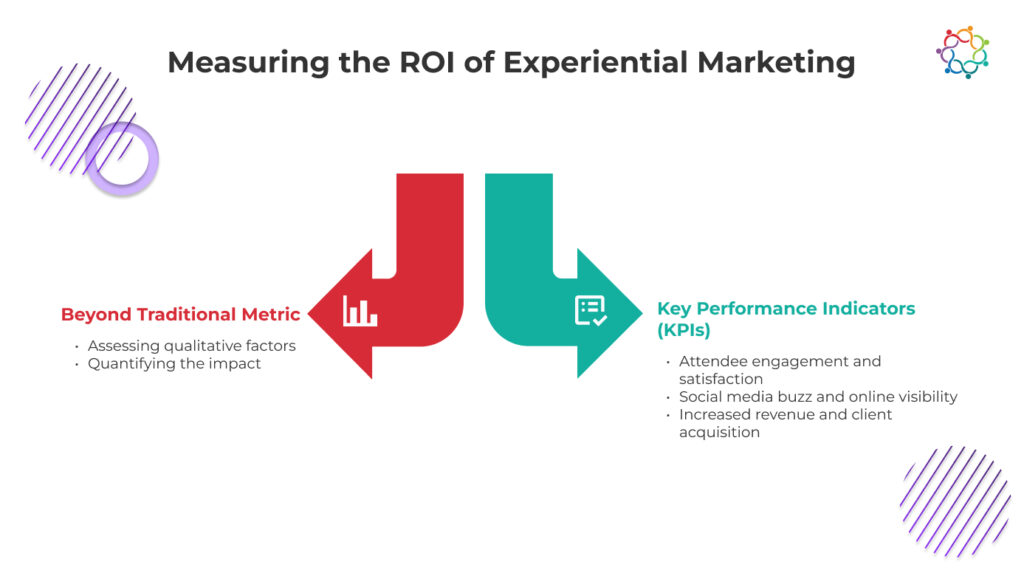
Beyond Traditional Metrics
When it comes to experiential marketing, ROI isn’t just about direct sales or new contracts signed. Metrics like client satisfaction, positive word-of-mouth, and brand perception often hold much more weight. Wealth management firms should look at the intangible benefits—such as client referrals, increased trust, and a stronger brand reputation—as key indicators of success.
Key Performance Indicators (KPIs)
For experiential marketing, KPIs may include attendee engagement rates, social media activity, and conversion rates for new client inquiries. Each of these metrics tells a story about how the event resonated with HNIs and whether it effectively met their expectations. Higher engagement rates and positive feedback from HNIs can point to a successful event, even if immediate revenue isn’t the primary outcome.
Conclusion
In conclusion, experiential marketing offers a powerful way for wealth management firms to cultivate meaningful, enduring relationships with HNI clients. By crafting high-quality, personalized experiences, firms can engage clients on a level that goes beyond traditional marketing methods, tapping into emotional connections and lasting impressions that deepen client loyalty. Investing in well-designed events can bring measurable returns, not only in terms of revenue but also in terms of client satisfaction and trust.
As experiential marketing evolves, integrating platforms like Samaaro can streamline event organization and attendee engagement, offering advanced personalization, analytics, and seamless user experiences through its intuitive mobile app. To explore how Samaaro can transform your event strategy, start with a Free Trial or Book a Demo today. The future of experiential marketing in financial services holds vast potential, with technology paving the way for ever-more connected, engaging, and impactful client experiences.

Built for modern marketing teams, Samaaro’s AI-powered event-tech platform helps you run events more efficiently, reduce manual work, engage attendees, capture qualified leads and gain real-time visibility into your events’ performance.
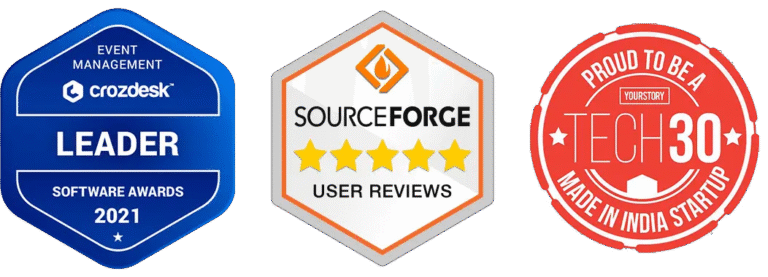
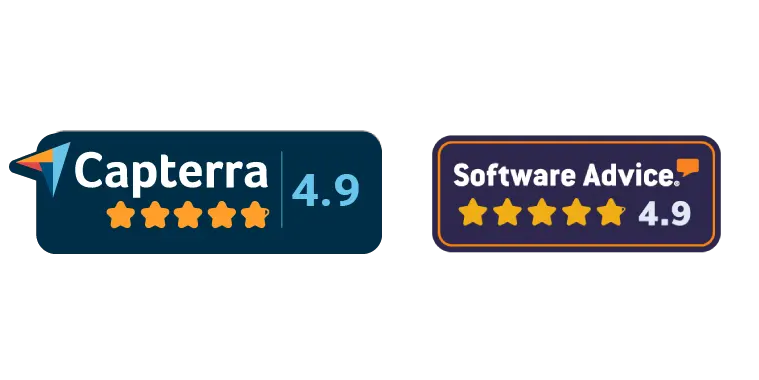
© 2025 — Samaaro. All Rights Reserved.